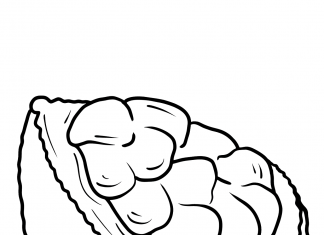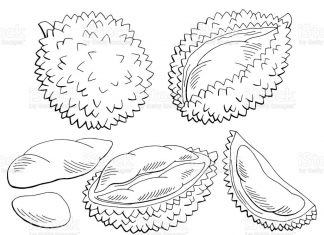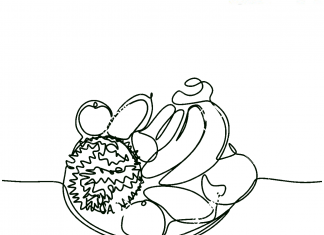Durian is an exotic fruit known primarily in Southeast Asia. It is often referred to as the "king of fruits" because of its unique flavor and aroma, but also because of its extremely strong, distinctive smell, which some people find pleasant, while others hate it.
Durian Coloring Book
information
- Appearance and texture: The durian has a spiky skin and can be quite large, weighing between 1 and 3 kg. Internally, the fruit contains several yellow or cream fleshy segments that surround large seeds.
- Taste and smell: The taste of durian is difficult to describe and varies depending on the variety. It can be sweet with a creamy note, and sometimes with hints of caramel, almond or sherry. However, it is its smell that is the most controversial, described as a mixture of socks, onions, cream and more.
- Varieties: There are many varieties of durian, each with a slightly different flavor and texture. The most popular variety is Durian Musang King.
- Nutritional Value: Durian is rich in calories, fiber, vitamins (especially vitamin C) and minerals. It is also a good source of fats and protein.
- Application: Durian can be eaten raw, but it is also an ingredient in many dishes and desserts in Southeast Asia, such as ice cream and cakes.
- Cultural issues: In some places, such as hotels and public transportation, there are bans on bringing durian because of its intense odor.
- Cultivation: Durian is mainly grown in Thailand, Malaysia and Indonesia, but can also be found in other Southeast Asian countries.
trivia
- Bans: Many public places in Asia, such as hotels, shopping malls and transportation, have durian bans due to its strong odor.
- Natural repellent: Wild animals such as tigers and lions avoid durians, probably because of their spiky skin and intense odor.
- Traditional beliefs: In some Asian cultures, durian is believed to have warming properties. There is a popular saying that drinking alcohol while eating durian can lead to overheating of the body and be dangerous, although there is no scientific evidence to support this belief.
- Price: Some durian varieties, such as Musang King, can be very expensive, costing up to hundreds of dollars per fruit, depending on the season and quality.
- Used in medicine: In some traditional cultures, durian leaves, roots and bark are used as a remedy for various ailments.
- Large seeds: Durian seeds are one of the world's largest fruits. They can be cooked and eaten like chestnuts.
- Sulfur content: Durian has a high sulfur content, which contributes to its characteristic odor. Sulfur also helps produce antioxidants in the fruit.
- Fragrance: Although many people hate the smell of durian, there are products such as ice cream, creams and drinks that try to mimic its taste without the strong smell.
- Applications: In addition to eating raw, durian is used to make a variety of products, such as cookies, ice cream, beverages and even durian chips.
- Symbolism: In some countries, such as Thailand, durian is a symbol of wealth and social status due to its high price and unique properties.




